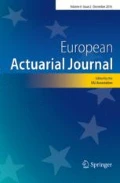Abstract
In this paper, we describe how Poisson regression analysis can be efficiently used to perform graduation of mortality rates in presence of exogenous information supporting an efficient underwriting process in life insurance business. After having justified the relevance of a Poisson likelihood for mortality data, we explain how categorical and continuous covariates can be included in the model. A case study based on a German insurance portfolio is proposed to illustrate the usefulness of the approach described in this paper.




Similar content being viewed by others
References
Brown RL, McDaid J (2003) Factors affecting retirement mortality. N Am Actuar J 7(2):24–43
Cossette H, Delwarde A, Denuit M, Guillot F, Marceau E (2007) Pension plan valuation and dynamic mortality tables. N Am Actuar J 11(2):1–34
DAV (2008) Herleitung der Sterbetafel DAV 2008 T für Lebensversicherungen mit Todesfallcharakter. DAV-Unterarbeitsgruppe Todesfallrisiko. Blätter der DGVFM 30(1):189–224
De Jong P, Heller GZ (2008) Generalized linear models for insurance data. Cambridge University Press, Cambridge
England PD, Haberman S (1993) A new approach to modeling excess mortality. J Actuar Pract 1:85–117
Fahrmeir L, Tutz G (2001) Multivariate statistical modelling based on generalized linear models. Springer series in statistics, 2nd edn. Springer, New York
Gerber HU (1997) Life insurance mathematics, 3rd edn. Springer, Berlin
Haberman S, Renshaw AE (1990) Generalised linear models and excess mortality from peptic ulcers. Insur Math Econ 9(1):21–32
Haberman S, Renshaw AE (1996) Generalized linear models and actuarial science. The Statistician 45(4):407–436
Laird NM, Olivier D (1981) Covariance analysis of censored survival data using log-linear analysis techniques. J Am Stat Assoc 76:231–240
Loader C (1999) Local regression and likelihood. Statistics and computing series. Springer, New York
Loader C (2010) locfit : local regression, likelihood and density estimation. R package version 1.5-6. http://cran.r-project.org/package=locfit
McCullagh P, Nelder JA (1989) Generalized linear models. Monographs on statistics and applied probability, vol 37, 2nd edn. Chapman & Hall/CRC Press, Boca Raton
R Development Core Team (2011) R: a language and environment for statistical computing. R Foundation for Statistical Computing, Vienna. http://www.r-project.org.
Regenauer A (2001) Kein Interesse am gläsernen Patient. Deutsches Ärzteblatt 98(10):A593–A596
Renshaw AE (1988) Modelling excess mortality using GLIM. J Inst Actuar 115:299–315
Renshaw AE (1991) Actuarial graduation practice and generalized linear and non-linear models. J Inst Actuar 118:295–312
Renshaw AE, Haberman S (1996) Dual modelling and select mortality. Insur Math Econ 19(2):105–126
Renshaw AE, Haberman S, Hatzopoulos P(1997) On the duality of assumptions underpinning the construction of life tables. ASTIN Bull 27(1):5–22
Sijbrands EJG, Tornij E, Homsma SJ (2009) Mortality risk prediction by an insurance company and long-term follow-up of 62,000 men. PLoS ONE 4(5):e5457
Vinsonhaler C, Ravishanker N, Vadiveloo J, Rasoanaivo G (2001) Multivariate analysis of pension plan mortality data. N Am Actuar J 5(2):126–138
Von Gaudecker H-M, Scholz RD (2007) Differential mortality by lifetime earnings in Germany. Demogr Res 17:83–108
Wood SN (2006) Generalized additive models—an introduction with R. Texts in statistical science series. Chapman & Hall/CRC Press, Boca Raton
Wood SN (2011) mgcv : GAMs with GCV/AIC/REML smoothness estimation and GAMMs by PQL. R package version 1.7-5. http://cran.r-project.org/package=mgcv
Acknowledgments
The authors would like to thank an anonymous reviewer whose suggestions improved the original manuscript. The data analysis in this paper was performed with R , statistical software which is released under the GNU General Public License (GPL). For more information on R , the interested reader is referred to R Development Core Team [14]. Beyond the R code we conceived ourselves, we benefitted in particular from the locfit package, described in Loader [12].
Author information
Authors and Affiliations
Corresponding author
Additional information
The views and opinions of authors expressed herein do not necessarily state or reflect those of the mentioned institutions.
Rights and permissions
About this article
Cite this article
Gschlössl, S., Schoenmaekers, P. & Denuit, M. Risk classification in life insurance: methodology and case study. Eur. Actuar. J. 1, 23–41 (2011). https://doi.org/10.1007/s13385-011-0028-y
Received:
Revised:
Accepted:
Published:
Issue Date:
DOI: https://doi.org/10.1007/s13385-011-0028-y




